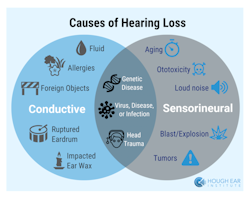Types of Hearing Loss
Hearing loss can be described as either conductive or sensorineural, or a combination of the two.
Conductive hearing loss. This type of hearing loss results from any condition in the outer or middle ear that interferes with sound passing to the inner ear. Excessive wax in the auditory canal, a ruptured eardrum, and other conditions of the outer or middle ear can produce conductive hearing loss.
Although work-related conductive hearing loss is not common, it can occur when an accident results in a head injury or penetration of the eardrum by a sharp object, or by any event that ruptures the eardrum or breaks the ossicular chain formed by the small bones in the middle ear (e.g., impulsive noise caused by explosives or firearms).
Sensorineural hearing loss. Sensorineural hearing loss is the most common type of hearing loss on the job. This type of hearing loss is a permanent condition that usually cannot be treated medically or surgically. Sensorineural hearing loss is associated with a problem occurring in either the inner ear or the auditory nerve, which delivers sound to the brain. The normal aging process and excessive noise exposure are both notable causes of sensorineural hearing loss.
Studies show that exposure to noise damages the sensory hair cells that line the cochlea. Even moderate noise can cause twisting and swelling of hair cells and biochemical changes that reduce the hair cell sensitivity to mechanical motion, resulting in auditory fatigue. As the severity of the noise exposure increases, hair cells and supporting cells disintegrate, and the associated nerve fibers eventually disappear.
Knowledge Check Choose the best answer for the question.
1-3. Which type of hearing loss is the most common on the job?
You forgot to answer the question!

